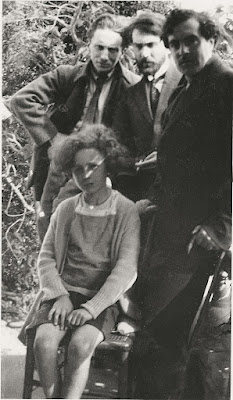VICTOR HUGO, ASTONISHING THINGS at the ROYAL ACADEMY on the 3rd of June 2025
VICTOR HUGO, ASTONISHING THINGS at the ROYAL ACADEMY on the 3rd of June 2025
Victor Hugo, The Town of Vianden Seen Through a Spider’s Web, 1871. Brown ink and wash, and blue watercolour over graphite on paper, 25.5 x 30.3 cm. Maisons de Victor Hugo, Paris / Guernsey. Photo: CCØ Paris Musées / Maisons de Victor Hugo
Victor Hugo’s fame rests
on his novels Les Miserables and Notre-Dame de Paris (in France
his poetry is also famous). This
exhibition proves the eclecticism and artistic talent of this versatile author.
 |
In total Hugo created
4,000 drawings of which 3,000 are still in existence. The Royal Academy presents about 70 of these
drawings, a mere snapshot of his entire output.
They are organised thematically to underline the claim made by one
Hugo’s admirers, Vincent Van Gogh, that his work consists of ‘astonishing
things’.
 |
Victor Hugo, The Cheerful Castle, c. 1847. Pen, brown and black ink and wash, crayon on cardboard, 15.8 x 22.2 cm. Maisons de Victor Hugo, Paris / Guernsey. Photo: CCØ Paris Musées / Maisons de Victor Hugo
Hugo’s father was a
general in Napoleon the Firsts army, but his son, perhaps in reaction to his
father’s influence, began his career as a monarchist. As Hugo’s life went on, he turned
increasingly toward the republican cause.
Hugo was exiled, initially to Belgium but latterly to Jersey and then to
Guernsey, after publicly criticizing Napoleon III, nephew of Napoleon Bonaparte
who had seized power in a coup. From
1855 onwards he lived in Hauteville House in St Peter Port in Guernsey.
 |
Victor Hugo, The Town of Vianden, with Stone Cross, 1871. Brown and black ink, brown and purple wash, graphite and varnish on paper, 25 x 34.5 cm. Bibliothèque nationale de France, Département des Manuscrits
The works on display here
underline his preoccupation with old European architecture, the castles both
real and imaginary he created. Hugo
worked mainly on paper with traditional materials, like pencil, charcoal, dark
hued washes and colouring pencils. In
other words, the small-scale materials employed by the amateur and part-timer,
but Hugo was neither of these. In fact,
Hugo had the capacity to be a major artist.
 |
Victor Hugo, Mirror with Birds, 1870. Hand-painted and inscribed wooden frame, oil paint, varnish, 70 x 65 cm. Maisons de Victor Hugo, Paris / Guernsey. Photo: CCØ Paris Musées / Maisons de Victor Hugo
Oddly these works recall
something more expansive, an unfinished collection, perhaps, that also implies
themes like the ocean, a trope that often features in Hugo’s work, as in his
novel of 1866 La Travailleurs de la Mer (Toilers of the Sea). Drawings of a causeway, an octopus (which
features in the novel), a light house and a rusting chain imply a fascination
with the sea and the littoral, where shore and sea embrace.

Victor
Hugo, Chain, 1864. Pen and brown ink on paper, 19.2 x 26 cm. Bibliothèque nationale de France,
Département des Manuscrits
These drawings are now
both light and moisture sensitive. They
are fragile and when they return to France, they will be kept from public view
for 50 years to preserve them.
 |
Victor Hugo, Octopus, 1866–69. Brown ink and wash and graphite on paper, 24 x 20.7 cm. Bibliothèque nationale de France, Département des Manuscrits
Hugo’s social conscience
is also at work in the drawings; he dedicated a depiction of a hanging to
executed abolitionist John Brown (1800-1859).
This work is titled Ecce Lex (Behold the Law - 1854). Hugo understood that the Union was now
finished but that slavery would be abolished because of John Brown’s martyrdom.
 |
| Victor Hugo, The Lighthouse at Casquets, Guernsey, 1866, Brown ink and wash, black crayon, black chalk and white gouache on paper, 89.8 x 48 cm. Photo: CCØ Paris Musées / Maison de Victor Hugo |
After the fall of Napoleon the Third in 1870, Hugo was able to return to Paris where he endured the Prussian siege of the city, but left before the Commune took power. He argued that the Communards ought to be spared and was subsequently exiled from Belgium for attempting to rescue fleeing members of the now defunct Commune. He left for exile in Luxembourg, yet another temporary home.
Hugo’s romantic temperament and intellect are all at work in these drawings which evoke his life and times succinctly and carefully. A rebel connected to a variety of causes, implacably hostile to the authoritarian forces ranged across the world, his work is also meticulously constructed and authentic, deserving our attention.
This is a succinct
introduction to Hugo’s drawings and sketches, an eye opener that details Hugo’s
life beyond the novels he’s famous for.
Paul Murphy, Royal
Academy, June 2025



Comments